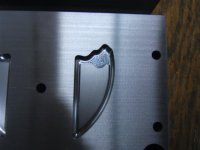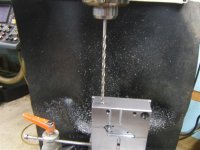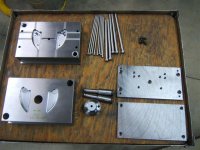diamondman
Cast Iron
- Joined
- Mar 17, 2005
- Location
- diamond ohio
Hi all,
It has been a while but thought you guys would like to see where
i am on this mold.
This is an insert tool for one of my customers.
The cavities are just roughed in using a .218 ball endmill. to leave finish stock I programmed the tool radius comp .008 larger the the tool
next I will finish the contour and depth (fixed half .118 deep, moving half .273 deep) with a .236 ball endmill.
Then finish the flat area around the hole with a 1/16" endmill.
The part sample is in this picture.
http://oi41.tinypic.com/2nqe4wn.jpg
This is a picture of the moving half showing the .025 step overs while roughing.
The finish step over will be .010
http://oi42.tinypic.com/2dlq886.jpg
No cam program was used to make this mold I used my cad program to get the points for tangent points and arc dimensions.
The whole program with 3 tool changes for both halves is 117 lines of code and 2,645 bytes of memory.
This is accomplished using the G79 contour pocket cycles, %*subroutine for the contour,looping blocks, G56 absolute offset
and mirror image G81.
I will post final pictures when I get it finished.
I cannot post the program for confidentially reasons But I got the O.K. to post generic pictures.
Dave
It has been a while but thought you guys would like to see where
i am on this mold.
This is an insert tool for one of my customers.
The cavities are just roughed in using a .218 ball endmill. to leave finish stock I programmed the tool radius comp .008 larger the the tool
next I will finish the contour and depth (fixed half .118 deep, moving half .273 deep) with a .236 ball endmill.
Then finish the flat area around the hole with a 1/16" endmill.
The part sample is in this picture.
http://oi41.tinypic.com/2nqe4wn.jpg
This is a picture of the moving half showing the .025 step overs while roughing.
The finish step over will be .010
http://oi42.tinypic.com/2dlq886.jpg
No cam program was used to make this mold I used my cad program to get the points for tangent points and arc dimensions.
The whole program with 3 tool changes for both halves is 117 lines of code and 2,645 bytes of memory.
This is accomplished using the G79 contour pocket cycles, %*subroutine for the contour,looping blocks, G56 absolute offset
and mirror image G81.
I will post final pictures when I get it finished.
I cannot post the program for confidentially reasons But I got the O.K. to post generic pictures.
Dave
Last edited:


 ) for a living,rebuilding engines used to be fun
) for a living,rebuilding engines used to be fun .Seriously though, can you really not compete with the chinese I mean do you have customers that tell you they can get it cheaper from chinga linga or is it like a silent disappearance where you just don't here from them again? I got to compete with low cost junk too, it pisses me off but it makes me hungrier and better. If you don't mind me asking what would a job like that pay in the good young USA. Regards,Mike
.Seriously though, can you really not compete with the chinese I mean do you have customers that tell you they can get it cheaper from chinga linga or is it like a silent disappearance where you just don't here from them again? I got to compete with low cost junk too, it pisses me off but it makes me hungrier and better. If you don't mind me asking what would a job like that pay in the good young USA. Regards,Mike




